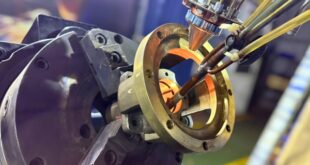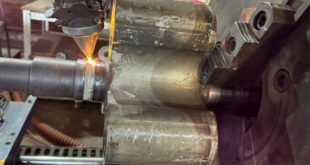Working conditions of rollers in steel rolling mills:
Rollers in steel mills often work in harsh environments such as high temperatures, sudden temperature changes, and are subjected to compressive forces from the weight of the billet weight plus rolling friction between the roller surface and billet surface run through.
The use of steel rollers in production requires them to have high strength and withstand great pressure. To ensure this, they are usually made from materials that are resistant to wear and tear such as alloy steel and cast iron.
Common damages of rollers:
There are many causes of roller damage in the steelmaking process. Here are some of the most common causes:
- Abrasion: The long and continuous use of the roller in the manufacturing process will lead to wear, causing scratches and reducing the durability of the roller.
- Impact: The roller may collide with other materials during manufacturing, causing scratches and damage.
- Excessive pressure: If the pressure applied to the roller is excessive, it may deform or break.
- Bad material: If the material used to manufacture the roller is not of good quality, it may be damaged after a period of use.
If the roller is damaged, the production process will be interrupted and the quality of the product will be affected. Therefore, it is very important to fix this problem.
Replacing new rollers often takes a long time to wait for a new production, and is expensive, so we can repair and restore the roller to save costs and ensure quick processing time.
Currently, Laser Cladding welding technology is the most advanced technology in the world and it has been applied to coating, restoring spair parts to their original size and gradually replacing traditional repair methods. Laser Cladding with material suitable for each position and working conditions of the roller to prevent wear, corrosion…
The process of repairing and restoring rollers by Laser Cladding technology:
- Dimension checking: check the wear.
- Surface treatment: peeling off the layer that is rusted, cracked, scratched…
- Surface cleaning: use laser beam to clean the surface to remove grease, rust remaining on the surface
- Heat to a minimum of 250°C before starting welding and maintain the same temperature (not to exceed 250°C ) throughout the welding process.
- Welding is carried out using Laser Cladding technology while maintaining a temperature of about 250°C throughout the welding process.
- Refinish the surface until the desired diameter is achieved. Surface parameters: Dimensions, surface roughness, concentricity must be strictly controlled to ensure the operating parameters of the roller after recovery. This greatly affects the service life of the roller after recovery.
Contact us for advice and support:
PHUONG DONG CO., LTD
Address: Lane 70, Dan Di, Uy No, Dong Anh, Hanoi, Vietnam
Whatsapp/Mobile: +84987.822.360 +84.979.395.735

 Laser Cladding Phương Đông
Laser Cladding Phương Đông


